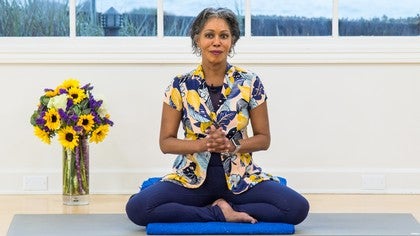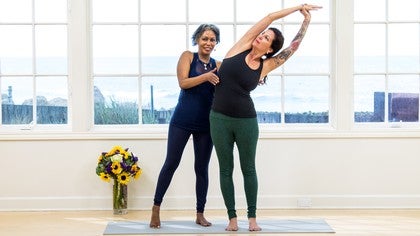Description
About This Video
Transcript
Read Full Transcript
Thank you for joining me for Foundations. So I want to give you an idea of the way that we work with the cognitive pieces of the 12-step program and the somatic pieces of yoga in Watavasar. This comes from a metaphor that I heard from my yoga therapy teacher years ago that I believe he got from the ancients. It's a metaphor that talks about us as humans as a vessel. The whole idea is that our work is to keep the vessel clear so that spirit, whatever it is that you relate to, as that bigger energy can work through us, so that spirit works through us. Well, addiction turns our vessel upside down. In my case, I was in the water upside down for many, many, many years and then I found the 12-step program and the first three steps of the 12-step program we called the foundation steps because they're foundational in helping us turn our vessel back right side up. So the vessel that was in the water for upside down all those years now needs a foundation in order to keep steady and solid on a new path. So the first three steps of the 12-step program are often called those foundational steps. This session is going to be all about foundation. Now we found that working with that, there's an analogy with working with that in the body. Wherever we are, whatever touches the earth is our base. It's our foundation and the posture that I'm in in this moment that happens to be my sits bones. My sits bones are what's touching the earth. So that represents my base, my foundation. So in any pose in my life on or off the mat, I want to have a solid foundation. I want to have a solid foundation. If my foundation is solid, then you know there's some steadiness to the structure. There's a possibility for steadiness to the structure. So we use the tools of yoga and by yoga I mean all pieces of yoga. So there's asana, there's pranayama, there's meditation, even the tools of chanting, all the tools of yoga. In addition to the tools of the 12-step program, in addition to methodologies from trauma healing, I assert that what sits underneath any addiction is some level of trauma, some level of nervous system dysregulation. So we use tools to support regulating our nervous system and in addition we use information. A lot of the things that we've gotten from all the inquiry in neuroscience about how addiction affects the brain. So we use all these things together in order to find a solid support so that vessels turn right side up, back right side up. And then we use the tools of the 12-step program and all those other methodologies in order to clean that vessel out and prepare it for sale. And then we set sail on our spiritual voyage.
We call these steps foundation, core, and expression. And we are going to do lectures and practices and little, these little mini interventions about each one of them, about each one of the sections. Steps 1 through 3 of the 12-step program really are all about us honestly accepting what is. So telling the truth about what's going on, honestly accepting what is. And once we honestly accept what is, the next thing we do is we stop and name the problem. As I said a little bit earlier, you cannot heal what you do not acknowledge. So it's very important for us to stop and name the problem. And then from there we recognize that there is a solution. But it's often going to take more than me. I'm the one that got me in the problem. So there is a solution that includes something beyond me. And then I make a decision to change. I make a decision to change. So these are the real basis of the first three steps, the foundational steps of the 12-step program. And again, as I spoke to a little bit earlier, the way that we translate this, the somatic pieces of this, so that I can really begin to embody recovery. Not just make it a mental thing, but embody recovery. Is that the first thing we start with is foundation. Connecting again with whatever is touching the earth. Find in this sense, once again, a reconnection with mother earth, it's herself, as well as this connection of what it is that we have lost. What it is that we lost. Well, we say the word recover. It indicates that there was something that was lost. So the idea of these three steps are to begin the process of reconnecting with the things that we had lost. One of them definitely for me was relationship with my body. As a matter of fact, using for me was a lot about running completely away from this body. All right. So now it's finding the invitation back in to reconnect with that which I've lost. What I found, and ultimately when we speak to how we really work with addiction in Y-12 SR, we frame it as the disease of the lost self. We lose ourselves. And so this is the first part of the invitation to come home, to come home, to come back to ourselves. So coming home first requires grounding. It requires us to really what I love to call root and ground. Otherwise, again, our foundation is shaky. And if a foundation is shaky, then the structure is not going to stand. So we use tools in Y-12 SR in order to find that sense of support, that connection in with mother earth. Some of these tools you'll see throughout the practices. As we embody foundation, as we embody grounding, we're able to have a structure that will allow us to feel our feelings. We have a basis from which to invite in emotions and feelings beyond labeling them. Good, bad, right, wrong. When we get into labeling, we hold feelings which are energy in a stagnant place where they cannot move. The nature of energy is to move. And when I hang on to it or deny them or pretend like they're not there, they don't move. My experience with energy that doesn't move is that it turns into something else. Anger will turn into rage, right? If it's not allowed to move.
There's no bad feeling. Feelings don't live in the domain of good, bad, right, wrong. They don't live in the domain of duality. When I even allow anger to move, it can turn into something that serves me versus something that does not support what I say is most important to me. Anger that's allowed to move can be strength. It can be motivation. So again, there's nothing good or bad or right or wrong about any feelings. Feelings are energy and the nature of energy is to move. So when I have a solid foundation, I have a place through which these emotions can flow, which is when I don't hang on to them and allowing them to turn into something different, something bigger that does not serve the things that I say are most important to me. In the 12-step program, what ultimately sits underneath the steps are what are called the spiritual principles, the spiritual principles. The spiritual principles that sit underneath the first three steps are honesty, open-mindedness, willingness, surrender, faith, and trust. These are the spiritual principles that sit underneath the steps. One of the things that we work very closely with in Y12SR is the embodiment of those spiritual principles. What does it really, really feel like in my body to surrender? What does surrender? For example, what does surrender feel like in my body? Well, here's an example for you and one that I often work with so often with many of the students, clients, friends, whatever with this one. If it doesn't feel like Shavasana, that feeling that you get in the final pose of the yoga class, you're there completely surrendered. The sense of freedom that comes with Shavasana, that's the embodiment of surrender. I will tell students, clients, if it doesn't feel like Shavasana, then it ain't surrender. It's not surrender, so don't kid yourself. If it doesn't feel like that, then it's not surrender. This is exactly what we work with in the practices. Hopefully, by the time this is all done, you will experience this for yourself in the practices. What we're going to do now with that basis for foundation, for this first piece, is we're going to move into a practice and what we call a little mini intervention. Again, this is just one of those embodiment tools that we can use in our lives when there needs to be a sense of re-regulation of our nervous system. Thank you so much.
Yoga of 12-Step Recovery
Comments
https://www.yogaanytime.com/class-view/2062/video/Yoga-Foundation-Practice-by-Nikki-Myers
You need to be a subscriber to post a comment.
Please Log In or Create an Account to start your free trial.















